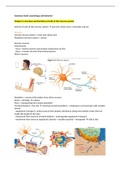Samenvatting
Summary Physiology of behavior (twelfth edition) - course biology psychology
- Instelling
- Vrije Universiteit Amsterdam (VU)
- Summary of the book 'Physiology of behavior (twelfth edition)' Neil R. Carlson • Melissa A. Birkett - Course: Biology psychology (Minor psychology and the brain) - English summary - Also with pictures of the book
[Meer zien]





